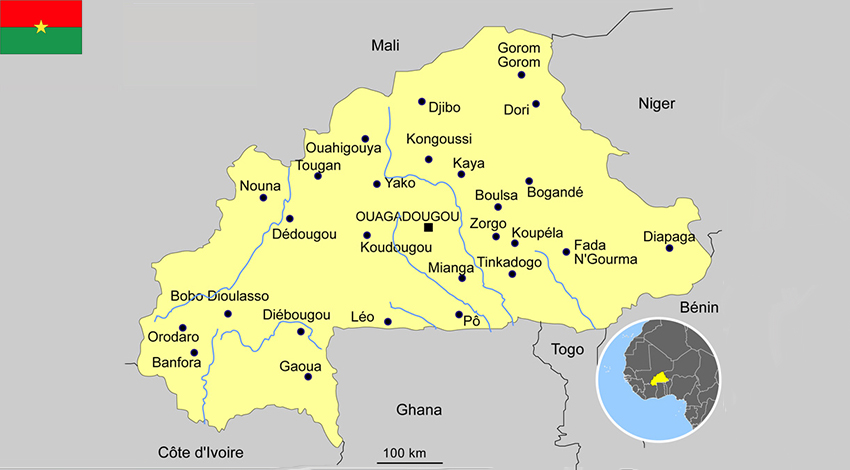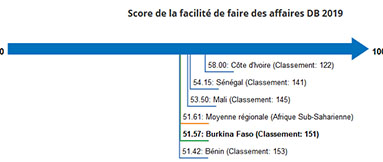
1.1 Political and geographical characteristics of Burkina Faso
Previously known as Haut Volta, Burkina Faso gained independence from France in 1960. Repeated military coups from 1971 to 1980 were followed by multi-party elections in the early 1990s. Former president Blaise Compaoré (1984-2014) resigned at the end of October 2014 following popular protest against his efforts to change the two-term presidential constitution. The president is elected directly by absolute majority, popular vote in 2 rounds if necessary for a 5-year term (eligible for a second term), the last election took place on 29 November 2015, the next will take place in November 2020. The Prime Minister is appointed by the President with the consent of the National Assembly.
- Area : 274,200 km2
- Population growth : 2,76%
- Population : 19,742,715 (July 2018)
- Urban population : 29,4% (2018)
- Density : 72 inhabitants/km2
- Official language : French
Burkina Faso is a member of the Conseil de l'Entente alongside Benin, Ivory Coast, Niger and Togo, the West African Economic and Monetary Union (WAEMU) and the Economic Community of West African States (ECOWAS).
1.2 Macroeconomic framework
| Classement Doing Business | 151th/190 |
| Note CPIA (policy and institutional assessment) | X,X World Bank classification |
| GDP per capita (2017) | 632 $ |
| Growth rates | 6,4% (2017 est.) |
| Inflation | 0.4 (2017 est.) |
Sources : https://www.cia.gov – http://documents.worldbank.org

Main exports
Gold, cotton, cattle
Human Development and Infrastructure

61.8% years old
Life experience (2018)

41,1%
Poverty line population

82,2%
(total population) Access to water

54,7 /1000
(2018 est.) Infant mortality

39,5
Distribution of family income GNI coefficient

17%
Access to electricity

25,9%
Malnutrition (total population)

36%
Adult literacy

89%
Cell phone access
1.3 Burkina Faso economic performance and outlook
Macroeconomic performance
Real GDP growth, at 6.7% in 2017, is expected to reach around 7.0% in 2018, mainly thanks to food agriculture (14.2%), mining (20.5%) and cotton ginning (8.0%). Final consumption is the main component of domestic demand. The tax burden fell from 16.5% of GDP in 2017 to around 18.0% in 2018, and public debt from 36.6% to 33.4% of GDP. Inflation reached around 1.4% in 2018, driven by higher food prices. The current account deficit improved to 7.2% of GDP in 2018, compared with 7.6% in 2017.
Outlook: positive and negative factors
Real GDP growth is expected to reach 6.0% in 2019 and 5.9% in 2020, driven mainly by cotton ginning, cash crops and financial services. The resumption of cooperation with China will support planned investment in sectors such as energy, which will boost economic growth. Installed electricity generation capacity is expected to reach 1,000 MW in 2020, up from 650 MW in 2018. On the demand side, final consumption and investment will remain the main drivers of GDP growth in 2019. Fiscal policy will aim to reduce the budget deficit to below 3% from the estimated 4.9% in 2018. The main interventions are aimed at improving agroforestry productivity and the manufacturing sector's contribution to GDP from 8% in 2018 to 12% in 2020.
Burkina Faso is pursuing reforms in several sectors. In the energy sector, the 2017 legislation broadening the powers of the Energy Regulatory Authority and the construction of eight additional solar power plants will add 100 M W to the country's installed capacity. In the agricultural sector, following the success of the Bagré growth pole project, Burkina Faso is continuing to develop growth poles. The establishment of a cotton ginning unit in Koudougou will contribute to local processing. For its part, the mining sector is forecasting 15,000 new jobs and FCFA 3.5 billion in investment in 2018. On the social front, as part of the policy of free healthcare, some 10.8 million cases of illness among children under the age of 5 have been treated.
Burkina Faso, which is a member of ECOWAS and UEMOA, nevertheless has weak trade relations with its regional partners, partly because of non-tariff barriers. The interconnection of the customs systems of Burkina Faso and Togo in May 2018 will reduce the time spent at the Cinkansé checkpoints from several days to around two hours. The free movement of goods and people is hampered by racketeering and other obstacles, compounded by the jihadist threat in the region. The banking system is integrated into the WAEMU payment system, and regional banking groups have rapidly established subsidiaries in the country.
Burkina Faso is a cultural crossroads in the ECOWAS region, hosting flagship events such as the Ouagadougou Pan-African Film and Television Festival and the Ouagadougou International Crafts Fair.
The country's prospects are threatened by social tensions, deteriorating security conditions and price rises dependent on rainfall and world prices for raw materials such as oil, gold and cotton. The fact that Burkina Faso is landlocked and dependent on its neighbours for transport means that transport costs account for up to 60% of the cost of goods, a situation exacerbated by the poor state of the infrastructure.
1.4 The business environment / Ease of Doing Business

Note: The Ease of Doing Business score tracks the gap between each economy and the best performance for each indicator, across all economies measured by Doing Business since 2005. An economy's Ease of Doing Business score is presented on a scale of 0 to 100, where 0 represents the lowest performance and 100 represents the best performance. The ease of doing business ranking ranges from 1 to 190.
Source : http://www.doingbusiness.org
- Benin (capital: Porto-Novo)
- Burkina Faso (capital: Ouagadougou)
- Cape-Verde (capital: Praia)
- Ivory Coast (capital: Abidjan)
- Gambia (capital: Banjul)
- Ghana (capital: Accra)
- Guinea (capital: Conakry)
- Guinea Bissau (capital: Bissau)
- Liberia (capital: Monrovia)
- Niger (capital: Niamey)
- Nigeria (capital: Abuja)
- Senegal (capital: Dakar)
- Sierra Leone (capital: Freetown)
- Togo (capital: Lomé)
Sectors of activity

Agro-industry

Health

Energy



